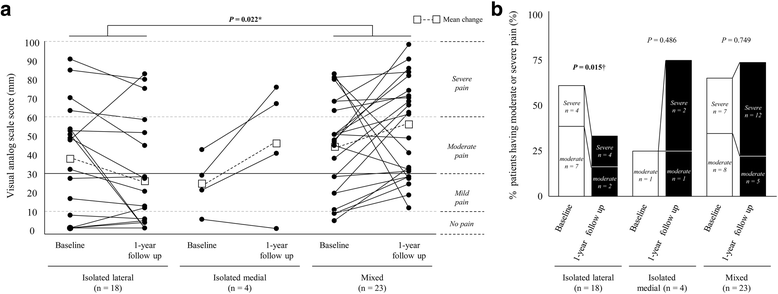Changes in clinical symptoms and functional disability in patients with coexisting patellofemoral and tibiofemoral osteoarthritis: a 1-year prospective cohort study
- PMID: 28340623
- PMCID: PMC5364585
- DOI: 10.1186/s12891-017-1486-4
Changes in clinical symptoms and functional disability in patients with coexisting patellofemoral and tibiofemoral osteoarthritis: a 1-year prospective cohort study
Abstract
Background: This 1-year prospective cohort study aimed to compare the changes in clinical symptoms and functional disability between patients with coexisting patellofemoral (PF) and tibiofemoral (TF) osteoarthritis (OA) and those with isolated TFOA.
Methods: Seventy-two patients with medial knee OA were enrolled. Knee pain and functional disability were assessed at baseline and at 1-year follow-up using the Japanese Knee Osteoarthritis Measure (JKOM) and a visual analog scale (VAS). We performed two-way analysis of covariance for the clinical outcome variables to examine, time (baseline and follow-up), group (coexisting PFOA and isolated TFOA), and time-group interaction effects. Furthermore, we conducted post-hoc exploratory analysis to address the possibility that dividing patients according to location of PFOA (i.e., isolated lateral, isolated medial, and mixed [bilateral]) may identify a distinct subgroup with different changes in clinical outcomes at 1-year follow-up.
Results: We detected group effects only in scores of the JKOM pain subscale (P = 0.012) and VAS (P = 0.033), adjusted for age, sex, and body mass index. Patients with coexisting PFOA have stable moderate level knee pain and functional disability throughout the year which is significantly worse than that in those with isolated TFOA. Post-hoc subgroup analysis demonstrated that change of knee pain likely varied with location of PFOA. Patients with isolated lateral PFOA had mild/moderate level knee pain, and their VAS scores were likely to improve, whereas those with mixed PFOA exhibited stable to worsening moderate/severe knee pain.
Conclusions: Although we did not detect differences in changes in clinical symptoms and functional disability between patients with coexisting PFOA and those with isolated TFOA, our findings indicate that patients with coexisting PFOA had worse clinical symptoms and functional disability than those with isolated TFOA. The results of the exploratory analysis suggested that patients with coexisting PFOA might have heterogeneous clinical outcomes, and presence of mixed PFOA might be an indicator of severe clinical knee OA.
Keywords: Disability; Knee pain; Patellofemoral osteoarthritis; Tibiofemoral osteoarthritis.
Figures

Similar articles
-
Incidence, prevalence, natural course and prognosis of patellofemoral osteoarthritis: the Cohort Hip and Cohort Knee study.Osteoarthritis Cartilage. 2017 May;25(5):647-653. doi: 10.1016/j.joca.2016.12.006. Epub 2016 Dec 9. Osteoarthritis Cartilage. 2017. PMID: 27940216
-
Clinical Impact of Coexisting Patellofemoral Osteoarthritis in Japanese Patients With Medial Knee Osteoarthritis.Arthritis Care Res (Hoboken). 2016 Apr;68(4):493-501. doi: 10.1002/acr.22691. Arthritis Care Res (Hoboken). 2016. PMID: 26315986
-
Gait patterns, symptoms, and function in patients with isolated tibiofemoral osteoarthritis and combined tibiofemoral and patellofemoral osteoarthritis.J Orthop Res. 2018 Jun;36(6):1666-1672. doi: 10.1002/jor.23805. Epub 2017 Dec 5. J Orthop Res. 2018. PMID: 29139573
-
Replacement for patellofemoral arthritis.Knee. 2019 Dec;26(6):1166-1170. doi: 10.1016/j.knee.2019.10.016. Epub 2019 Nov 5. Knee. 2019. PMID: 31699493 Review.
-
Is There a Biomechanical Link Between Patellofemoral Pain and Osteoarthritis? A Narrative Review.Sports Med. 2016 Dec;46(12):1797-1808. doi: 10.1007/s40279-016-0545-6. Sports Med. 2016. PMID: 27142536 Review.
Cited by
-
Patellar malalignment correlates with increased pain and increased synovial stress hormone levels-A cross-sectional study.PLoS One. 2023 Jul 27;18(7):e0289298. doi: 10.1371/journal.pone.0289298. eCollection 2023. PLoS One. 2023. PMID: 37498905 Free PMC article.
-
Local associations between knee cartilage T1ρ and T2 relaxation times and patellofemoral joint stress during walking: A voxel-based relaxometry analysis.Knee. 2018 Jun;25(3):406-416. doi: 10.1016/j.knee.2018.02.016. Epub 2018 Apr 19. Knee. 2018. PMID: 29681528 Free PMC article.
-
Does arthroscopic patellar denervation with high tibial osteotomy improve anterior knee pain?J Exp Orthop. 2021 Nov 9;8(1):104. doi: 10.1186/s40634-021-00411-5. J Exp Orthop. 2021. PMID: 34750692 Free PMC article.
-
Symptomatic knee osteoarthritis is associated with worse but stable quality of life and physical function regardless of the compartmental involvement: Data from the OAI.Osteoarthr Cartil Open. 2020 Nov 1;2(4):100117. doi: 10.1016/j.ocarto.2020.100117. eCollection 2020 Dec. Osteoarthr Cartil Open. 2020. PMID: 36474888 Free PMC article.
-
Decision-making factors and their thresholds for total knee arthroplasty in lateral tibiofemoral osteoarthritis patients: a retrospective cohort study.Knee Surg Relat Res. 2022 Oct 23;34(1):41. doi: 10.1186/s43019-022-00168-w. Knee Surg Relat Res. 2022. PMID: 36274181 Free PMC article.
References
-
- Vos T, Flaxman AD, Naghavi M, Lozano R, Michaud C, Ezzati M, Shibuya K, Salomon JA, Abdalla S, Aboyans V, et al. Years lived with disability (YLDs) for 1160 sequelae of 289 diseases and injuries 1990-2010: a systematic analysis for the Global Burden of Disease Study 2010. Lancet. 2012;380(9859):2163–2196. doi: 10.1016/S0140-6736(12)61729-2. - DOI - PMC - PubMed
-
- Pisters MF, Veenhof C, van Dijk GM, Heymans MW, Twisk JW, Dekker J. The course of limitations in activities over 5 years in patients with knee and hip osteoarthritis with moderate functional limitations: risk factors for future functional decline. Osteoarthritis Cartilage. 2012;20(6):503–510. doi: 10.1016/j.joca.2012.02.002. - DOI - PubMed
-
- Nicholls E, Thomas E, van der Windt DA, Croft PR, Peat G. Pain trajectory groups in persons with, or at high risk of, knee osteoarthritis: findings from the Knee Clinical Assessment Study and the Osteoarthritis Initiative. Osteoarthritis Cartilage. 2014;22(12):2041–2050. doi: 10.1016/j.joca.2014.09.026. - DOI - PMC - PubMed
Publication types
MeSH terms
LinkOut - more resources
Full Text Sources
Other Literature Sources
Medical
Miscellaneous

